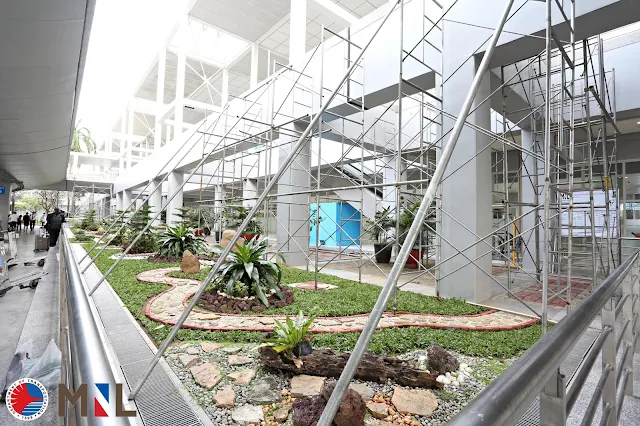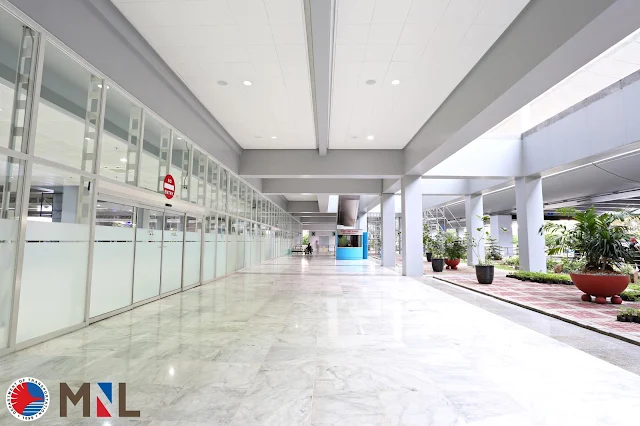GOOD NEWS: NAIA Terminal 2 Rehabilitation Getting Closer to Completion!
 |
| The rehabilitation of the Ninoy Aquino International Airport’s Terminal 2 is in its final phase and is expected to be completed on or before the end of the month. |
The rehabilitation project for the NAIA Terminal 2 has already reached 98.10% overall progress rate, as of 11 January 2021!
 |
| Terminal 2 of the Ninoy Aquino International Airport (NAIA) Garden Area |
The rehabilitation of Terminal 2 of the Ninoy Aquino International Airport (NAIA) is expected to be completed by the end of this month, the Department of Transportation (DOTr) said on Friday.
 |
| Entrance Area: Terminal 2 of the Ninoy Aquino International Airport (NAIA) |
The project involves major works to improve the terminal, in regard to its architectural, functional, and operational requirement, which will further enhance the terminal’s passenger movement, both for international and domestic flights, as well as the departure and arrival.
Slated to be completed by the end of January this year, the rehabilitation project aims to provide the air-riding public with a much-improved service and an air travel experience like no other!
 |
| To complement the expansion, there will be an additional air-conditioning system, power, lighting, fire protection, electronics and communications systems. |
In February 2019, Manila International Airport Authority (MIAA) General Manager Ed Monreal said the rehabilitation project was slated to be complete by March 2020 but was delayed after the onset of the coronavirus pandemic.
 |
| The temperature inside the building had also been affected because the air ducts within board-up areas could not be used. |
The rehabilitation of the NAIA Terminal 2 started in late October 2018 with a winning bid amount of PHP601 million to improve the whole terminal and to prepare it for the terminal realignment plan.
 |
| The replacement of the glass doors at the pre-departure gates and fixed bridge gates and the cleaning and polishing of metal frames, metal louvers and claddings will be undertaken. |
 |
| Marked improvement would soon greet passengers with the expansion of the departure check-in hall and the arrival baggage area. |
 |
| Improvements and reconfiguration of the existing airport terminals with the aim of improving the NAIA’s capacity from 31 million passengers per annum to 47 million passengers. |
According to the MIAA, the rehabilitation of the NAIA Terminal 2 involves an architectural facelift, replacement of damaged floors, and restoration and chemical cleaning of stained floor finish in the arrival and departure areas.
[Photo Courtesy: Ninoy Aquino International Airport MIAA]
TIMELINE: The NAIA rehabilitation project
From its humble beginnings as a United States Air Force base, the Ninoy Aquino International Airport eventually evolved into the country's main international gateway.
However, with tens of millions of travelers flying in and out on a yearly basis, congestion had plagued NAIA prior to the coronavirus pandemic as no alternatives were in place to help ease the airport's air traffic.
The government has since greenlit multi-billion peso upgrades of select airports across the country, and even the construction of a new one in Bulacan. Yet the rehabilitation of NAIA itself has faced numerous setbacks over the years, with negotiations between the government and various conglomerates invariably reaching a dead end.
Here's a timeline of events:
March 3, 1972: President Ferdinand Marcos signs Executive Order No. 381, which authorizes the development of the Manila International Airport with the establishment of a Committee on MIA Rehabilitation and Improvement.
International passenger traffic grows immensely during the 1970s, which leads to the construction of Terminal 1 in 1981, according to the Manila International Airport Authority.
August 21, 1983: Senator Benigno "Ninoy" Aquino Jr. is assassinated on the tarmac of the Manila International Airport.
November 27, 1987: Republic Act No. 6639, which renames the Manila International Airport to Ninoy Aquino International Airport, is enacted without executive approval under President Corazon Aquino's administration.
Air traffic in the NAIA continues to skyrocket throughout the years, with NAIA Terminal I hitting its intended capacity of 4.5 million passengers in 1991, said the MIAA. Despite various improvements increasing its design capacity by 1.5 million, the terminal yet again experiences an overflow of passengers in 1997 as they breach 7.7 million.
With this, the Philippine government pursues the construction of Terminals III and III within NAIA.
June 9, 2008: President Gloria Macapagal-Arroyo signs Executive Order No. 732, which establishes a task force to ensure the immediate opening and operation of Terminal 3. The terminal becomes fully operational over a month after.
2011-2013: Decades of air traffic congestion and problems with operations eventually catch up to NAIA, with the gateway being crowned the worst airport in the world by travel website "The Guide to Sleeping in Airports." NAIA also places among the worst airports in Asia in 2015 and 2016, but eventually gets out of the list in 2017.
February 12, 2018: The NAIA Consortium formally submits its unsolicited proposal to rehabilitate NAIA to the Department of Transportation. The group is composed of Aboitiz InfraCapital, Inc.; AC Infrastructure Holdings Corp.; Alliance Global Group, Inc.; Asia's Emerging Dragon Corp.; Filinvest Development Corp.; JG Summit Holdings, Inc. and Metro Pacific Investments Corporation, the biggest conglomerates in the country.
In an interview with CNN Philippines' Rico Hizon in July 2020, San Miguel President and COO Ramon Ang also reveals they were the first to submit an offer to upgrade the airport, but was told the project should be kept "for somebody else to compete with us at the time."
May 1, 2019: Following threats to cancel the project, Transportation Secretary Arthur Tugade accepts the consortium's revised proposal after both the government and the group of conglomerates finally get on the same page on the deal.
July 5, 2019: The Transportation Department returns the NAIA Consortium's latest pitch for improving the airport, noting it still falls short of the government's vision for the gateway. The business groups were asked to revise the agreement similar to the Clark O&M model.
November 29, 2019: The National Economic and Development Authority (NEDA) Board approves the NAIA Consortium's proposal to rehabilitate NAIA after undergoing several revisions. The plan was originally set at ₱350 billion for a 35-year concession period, but was eventually scaled down to ₱102 billion for a 15-year deal.
March 9, 2020: Metro Pacific confirms its intent to withdraw from its former consortium's plan to upgrade the gateway, citing issues with real property taxes.
July 7, 2020: The NAIA Consortium says authorities rejected its revised proposal to rehabilitate NAIA after subjecting its draft contract to multiple changes.
July 17, 2020: The duo of Megawide Construction Corporation and India-based GMA Infrastructure Limited (Megawide-GMR), which upgraded the "model" Clark International Airport and the Mactan-Cebu International Airport, bags the official proponent status for the airport's upgrade.
November 23, 2020: Megawide reiterates it can fund the rehabilitation of NAIA after NEDA and the Finance Department returned its proposal to take on the project, questioning the company's financial capacity.
December 15, 2020: Megawide announces the revocation of its original proponent status for the airport's rehabilitation, effectively delaying plans to improve NAIA.
December 17, 2020: In a Senate committee hearing, MIAA general manager Ed Monreal confirms San Miguel Corporation has submitted a proposal to operate and maintain NAIA. He also reveals Philippine Airport Ground Support Solutions Inc. as the second proponent seeking to run the international gateway.
During the same hearing, Tugade says Megawide still has a window of opportunity to persuade the MIAA board it can once again be the rehabilitation project's contractor.
December 21, 2020: Megawide submits a formal appeal to the DOTr and MIAA seeking the reinstatement of its original proponent status for the airport's long-delayed repair and upgrade.
January 16, 2021: Manila International Airport Authority (Miaa) board affirmed the revocation of the Megawide Construction Corp.-GMR Infrastructure consortium’s primary rights, otherwise called an original proponent status (OPS), to redevelop and operate Naia at no cost to the government





No comments:
Got Something to Say? Thoughts? Additional Information?